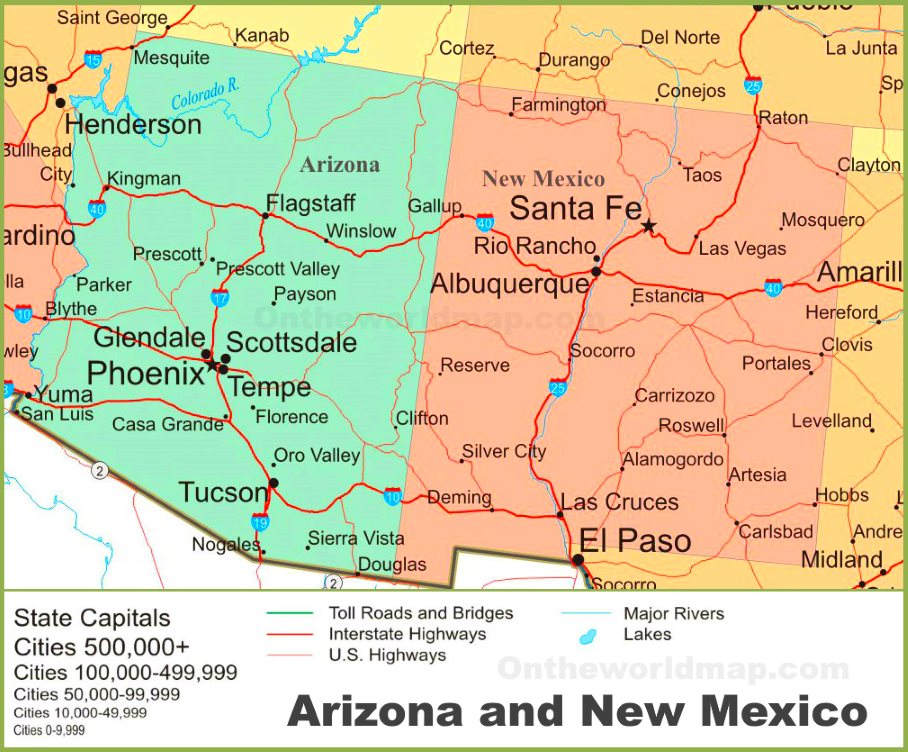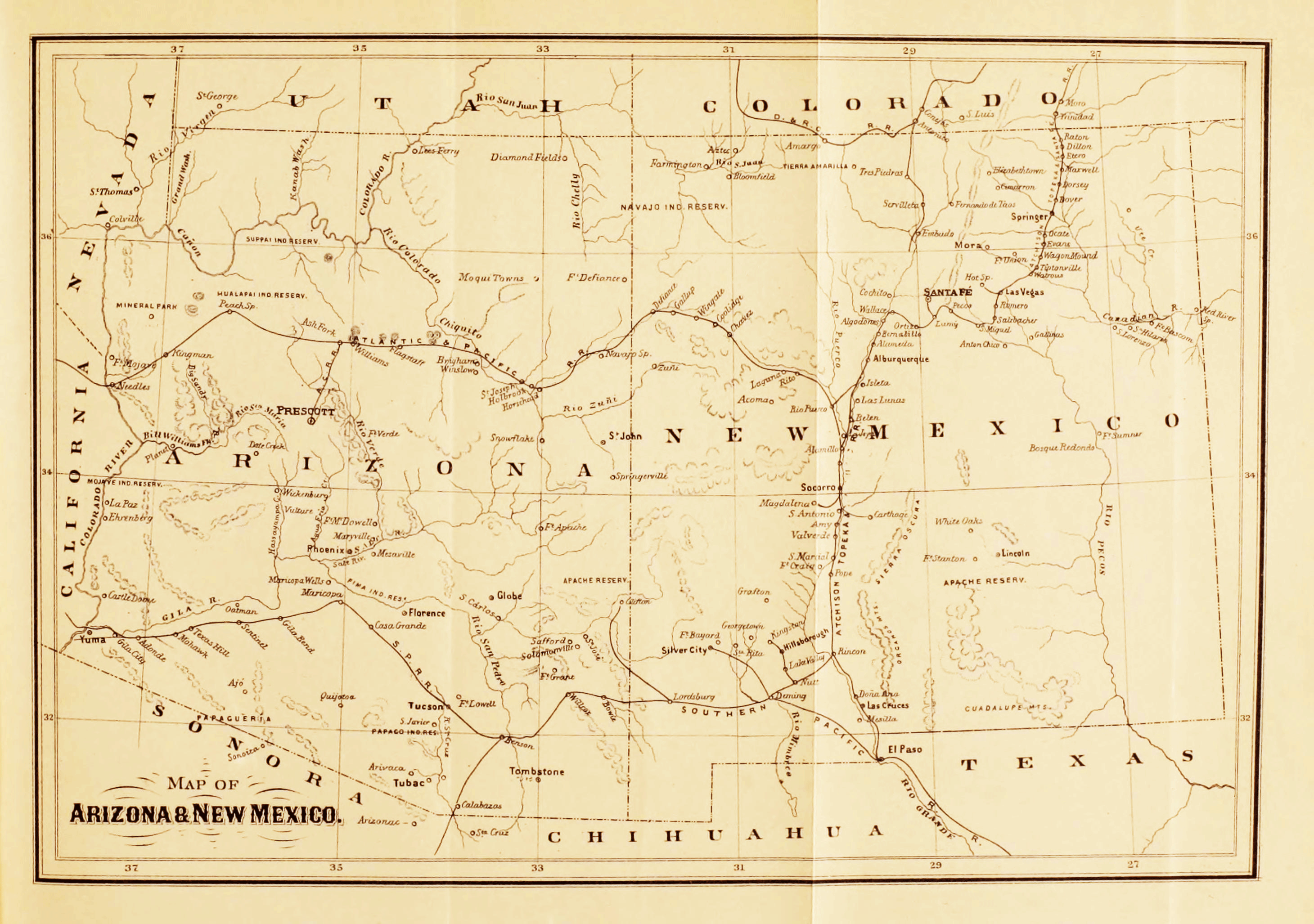

 |
 |
HISTORY OF ARIZONA AND NEW MEXICO
1530—1888
CONTENTS
CHAPTER I. INTRODUCTORY REMARKS AND RÉSUMÉ
|
 |
PREFACE.
For several reasons, the history of Arizona and New Mexico, particularly
in the early times, is not surpassed in interest by that of any portion of the
Pacific United States, or perhaps of the whole republic. Notable among these
reasons are the antiquity of these territories as Spanish provinces—for they
were the first to be occupied by Europeans, and ten years before the Pilgrims
landed at Plymouth Rock, a Historia de la Nueva Mexico was published; the
peculiar Pueblo civilization, second only to that of the Aztecs and Mayas in
the south, found among the aborigines of this land, and maintaining itself more
neatly in its original conditions than elsewhere down to the present day; the
air of romance pervading the country’s early annals in connection with the Northern
Mystery, quaint cosmographic theories, and the search for fabulous empires in Cíbola, Teguayo, and Quivira; the
ancient belief in the existence of immense mineral treasures as supplemented by
the actual discovery of such treasures in modern times; the long and bloody
struggle against raiding Apaches, the Ishmaelites of
American aborigines; the peculiar circumstances under which this broad region
fell into the hands of the United States; the fact that the eastern portion,
unlike any other territory of the republic, is still inhabited mainly by a
Spanish-speaking people; its position on the national frontier; its
peculiarities of physical configuration and climate; and finally, the marvellous strides towards prosperity in the last decade,
of a country formerly regarded as an unpromising section of the Great American
Desert
That the annals of these countries, so extensive both chronologically
and territorially, are compressed into one volume of this History of the
Pacific States, while seven volumes are devoted to the record of a sister
province, California, is a fact that may seem to require a word of explanation,
though it is in accordance with a plan deliberately formed and announced at the
outset. All Spanish-American provinces are in certain respects so similar in
their annals one to another that it was and is believed sufficient and best in
a comprehensive work like this to present the minutiae of local and personal
happenings of but one. California was chosen for this purpose, not only because
of its modern prominence, but because its records are remarkably perfect, and
because its position on the coast, facilitating intercourse with Mexico and
foreign nations, its mission system, its trading and smuggling experience, its
Russian complications, its political vicissitudes, and its immigrant and other
foreign elements gave to its history, as compared with that of interior
provinces, a notable variety, tending greatly to mitigate the inevitable
monotony of all provincial annals, even before the knowledge of its golden
treasure came to startle the world. The history of New Mexico written on the
same scale as that of the Pacific province would not only fill many volumes,
but from the lack of continuous archive evidence, and from the fact that the
story goes back beyond the aid of memory, it would be at the best fragmentary
and irregular; and by reason of the country’s isolation and non-intercourse
with the outer world, as well as on account of the peculiar nature of its petty
events, it would also be most tedious reading. Not only is this true of the
first and most important period of the country’s history—that of Spanish rule
to 1821—but of the second period, embracing the Mexican rule of 1822-46, the
growth of the Santa trade, the change of flag, the Indian wars, and the early
territorial days down to 1875 or later. The Mexican archive record is more
meagre even than the Spanish, the early enthusiasm of conquest and exploration
had died out, nothing more monotonous in detail than the endless succession of
Indian wars can be imagined, and of the more important events and developments
several are more conveniently and satisfactorily treated in the annals of other
adjoining regions. And as to the third and last period, that of railroads,
Indian reservations, mining development, industrial progress, and American
immigration, a valid reason for condensation is found in the fact that this
grand unfolding of resources has but just begun, that all is in a transitory,
changeable condition, so that the result of the most minute treatment would
probably become antiquated and of comparatively little value within a few
years. Thus there are good reasons for the plan and
scale I have adopted. The omission of personal and local details, moreover,
adds greatly to the interest of this volume; and so far as the general course
of events and developments is concerned, no volume of the series has been
founded on more careful or exhaustive research.
My sources of information for this volume are shown in the list of
authorities prefixed, in the fine-print appendix to the first chapter, and in
the notes scattered profusely throughout the work. In no section of the field
have my resources of original data been richer or more varied. Besides many
rare works in print consulted only imperfectly or not at all by previous
writers, I have consulted the Santa Fé archives, and have had access to rich
stores of the most important documentary records from Spain and Mexico in my
own and other private collections; and I have been especially fortunate in
being able to utilize, practically for the first time, the work of Villagrá and several important documents bearing on Oñate’s conquest, never before correctly recorded. For
later events of territorial history I have studied all
the publications extant, including government reports and newspapers; and have
besides, here as in the other parts of ray field, taken the testimony of many
prominent citizens and officials who have thrown new light on many phases of
the subject. Here as elsewhere I give full credit to the sources on every
point.
Several praiseworthy works on the history of these territories have been
published; but they are of a very uneven quality, with not a few errors, and
more omissions—defects due in most cases not so much to the incompetence of the
author as to the inaccessibility of original authorities. Nowhere in my work
have I been able to correct more erroneous statements, fill more historical
gaps, or, except in the matter of minute details as already explained, to
supply in comparison with preceding writers more new
matter. Yet experience leads me to expect that the old inaccurate and
thread-bare sources will still be consulted to a considerable extent in
preference to better and original authorities at second-hand. Doubtless writers
will continue to give inaccurate dates and details for Oñate’s conquest; to seek new locations for Coronado’s Cíbola and Tiguex; to name Cabeza de Vaca as the discoverer of New Mexico, and speak of his descendants as still living
in the country; to talk of the Aztecs and of Montezuma in this northern region;
to describe Santa Fé as the oldest town in the United States, dating its
foundation back to the sixteenth or fifteenth century, or that of Tucson to the
sixteenth; to chronicle the expedition of Peñalosa to
Quivira; to name the duke of Alburquerque and other
viceroys among the governors of New Mexico; to derive the name of Arizona from
‘arid zone’ or ‘narizona’, the big-nosed woman; to
accept the current traditions of rich mines of gold and silver discovered and
worked by the Jesuits and conquerors, or by enslaved Indians under their cruel
direction; and to repeat various other errors that have found place in the
legendary annals of these provinces. However, I have presented the facts and
the evidence on which they rest. My statements should be accepted or disproved.
Arizona and New Mexico are properly presented together in one volume, as
they have historically and physically much in common. In Spanish and Mexican times they were practically or to a great extent one
country, and their annals are accordingly somewhat intermingled; but the
chapters devoted to each, though mixed in the order of presentment, are kept
distinct in substance, so that the record of each province may be read
continuously. Since their organization as territories of the United States the
history of each is given separately in consecutive chapters. As between the two
there is no difference in scale or treatment, though I have been able slightly
to condense the earlier Arizona record because of Pimería having been covered by the history of Sonora in another volume, and though New
Mexican history is much more voluminous in the aggregate by reason of its
greater chronologic extent.
Though first among the Pacific States to be settled by Europeans,
Arizona and New Mexico have been last to feel the impulse of progressive
civilization; yet they have felt it, and as a result must assume good rank
among their sister states. In natural conditions of healthful climate, fertile
soil, and mineral wealth, the two territories closely resemble each other; and
while Arizona has the advantage of a less apathetic and ignorant population,
and thus far takes the lead in mining and agricultural industry, their
aspirations and possibilities are similar, and ultimate precedence is by no
means assured to the western territory. Both, as it has proved, are fortunate
in their mid-continental position, which has given them railroad communication
with the east and west and south long before they could have expected it
otherwise. Both have made a good start in the race, and in each the spirit of
progress is actively working. Ultimate success is not doubtful. The danger of
serious Indian troubles is believed to be past; the old and absurdly inaccurate
ideas of the east respecting this country and its people are rapidly
disappearing; and the present invasion of the farther west by climate-seekers
cannot fail to benefit the interior. When the mining industry shall have been
more fully systematized, workings being directed somewhat more to mineral lodes
and somewhat less to the pockets of outside speculators; when the senseless
national raid against bimetallic currency shall be at an end; when systematic
irrigation works shall make available the water resources; when the government
shall provide for the sale of the mesa lands in tracts of convenient size for
stock-raising; when the population of Mexican race shall adopt improved methods
of tillage or make way for others who have adopted them; when the immense
deposits of iron and coal shall be utilized—then will come the day of great and
permanent prosperity for this land of old-time mystery. All this will not be
done in a year or in ten; but it will be done. Then the historic records of
this volume will have a new and ever-increasing interest.
